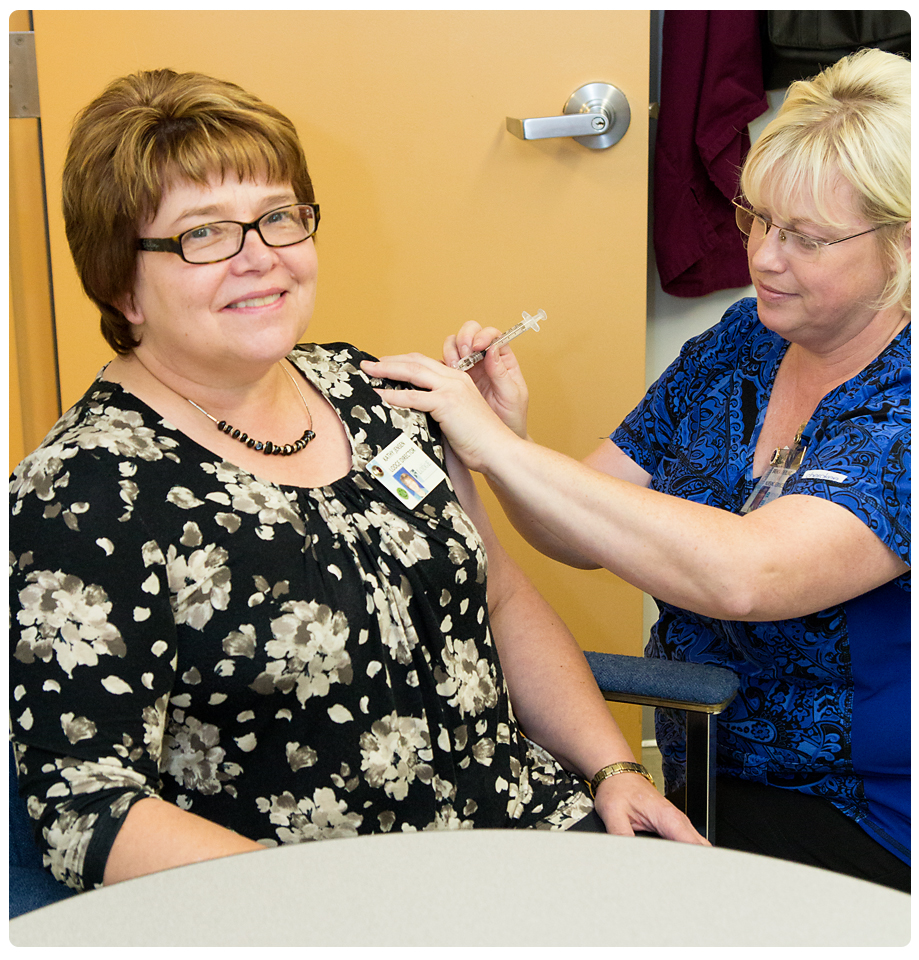
The CDC recommends that everyone aged 6 months and older have a yearly flu vaccine. One change for this year is the recommendation to use the intranasal vaccine for healthy children aged 2 to 8 years of age. It works better for this age group, but the shot still works for in these children – and in some cases the intranasal vaccine is not recommended. Consult your child’s health care provider for details.
Vaccination is especially important for people aged 65 years or older because they are at increased risk for complications from flu. Regardless of your age or state of health, though, you should get a yearly flu shot. Of course we don’t want you to get sick, but if you do get the flu, you could pass this deadly disease to your aging mother or asthmatic neighbor – which is a big reason why everyone should get vaccinated.
For people aged 65 years or older, there are now two flu injections to choose from: a “regular dose” flu shot and a new “high dose” flu shot. This shot (“Fluzone High Dose”) contains four times the amount of antigen contained in regular flu injections, and confers better immunity than the standard dose vaccine. In the absence of widespread availability of this more expensive agent, the CDC has not made strong recommendations for this vaccine over the standard dose.
There is also a new quadrivalent influenza vaccine, which contains antigenic components of two “A” strains and two “B” strains. Epidemics of influenza B occur every 2 to 4 years in all age groups, and is a common cause of influenza problems in children. The most important thing is not which flu shot you get – but that you get one! And this is the ideal time to get your yearly influenza vaccine.
Many people tell me that the flu is “no big deal,” and they “only get the flu” when they get the flu shot. These are just a few of the many misconceptions that surround this disease. Influenza, for example, is far different from the “common cold.” Colds come on gradually, are usually mild, cause a scratchy throat, may be associated with a runny nose, and resolve in 3-4 days without any treatment. Influenza, on the other hand, usually has an abrupt onset, sore throat, cough, wheezing, has a high fever, severe headache, and is accompanied by diffuse aches and pains. Vomiting and diarrhea is not a part of true influenza.
The flu shot is 70-90% effective in building up your body’s antibody level to prevent influenza infection. It is your body’s ability to mount an immune response that can cause mild pain at the injection site and a low-grade fever. You can also get a runny nose and mild “flu like” illness. That is a lot better than having a 106 degree fever and influenza-related pneumonia! And concerns about Guillain Barré syndrome from flu vaccines are grossly distorted. Flu vaccine related Guillain Barré syndrome (ascending paralysis, generally reversible) affects about 1 out of a million vaccine recipients, compared to 17 out of a million influenza-infected patients.
If you forget to get the flu shot, or if you think you have the flu despite being vaccinated, then you should notify your health care provider. A reasonably accurate diagnosis can usually be made over the telephone. Most of the time the best thing to do is to stay at home, get plenty of rest, drink lots of fluids, and avoid spreading the infection to others in your school or workplace. Sometimes your health care provider may order a rapid influenza test. Although the reliability of these tests is not perfect, they can help tell us what is going through the community. There are antiviral drugs (Tamiflu and Relenza) that can lessen the severity and duration of an influenza infection. These medications are most effective if started within 48 hours of the onset of symptoms. If you are “really sick” with influenza related disease (pneumonia, dehydration, delirium, etc.) you should be hospitalized for intravenous fluids, antibiotics, and breathing treatments.
This has been a brief summary of “recent updates” for the 2014-2015 influenza season. Contact your health care provider for more information. The disease has been around for a long time. It may not be as exciting as Ebola, MERS, SARS, and some of the other things we have been hearing about lately – but it is still a killer. And it is something we can prevent! So head down to your local clinic, health department, workplace, or pharmacy to get your yearly flu shot.
by Jerome Kessler, MD
